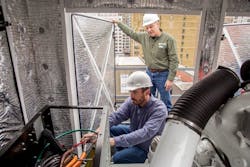Since 1974, Ronald McDonald Houses have been serving families of seriously ill or injured children receiving treatment far from home, providing lodging, meals, and more at little or sometimes no cost. Today, there are 322 Ronald McDonald Houses in 57 countries, the largest being Ronald McDonald House New York.
Located on Manhattan’s Upper East Side, the 13-story, 70,000-sq-ft brick building provides temporary housing to as many as 84 families. Though its living spaces are modern, the systems serving them dated to the facility’s opening in 1989.
“The boiler and chillers were past their life cycle,” Ike Beyer, owner of Integrated HVAC Systems and Services Inc., said. “As a non-profit organization, the project’s payback and sustainability were equally important as the initial cost.”
Beyer worked with Chris Cafer, associate and senior mechanical engineer for Energy Concepts Engineering, to design and install new systems at Ronald McDonald House New York. Their firms’ decades of experience would lead to a solution surpassing facility managers’ expectations of comfort and sustainability.
At every step of the renovation, Mel Farrell, BSEE, chief engineer for Ronald McDonald House New York, was intimately involved.
“If” Before “How”
In 2011, long before any plans for a retrofit were drawn up, Energy Concepts Engineering began a study to determine if combined heat and power (CHP), or cogeneration, would be right for Ronald McDonald House New York.
“All applications are different, based on energy-use trends and the physical structures themselves,” Cafer explained. “We took a holistic approach; energy models were developed based on past use and projected costs.”
The study was funded in part by New York State Energy Research and Development Authority (NYSERDA).
After two years of research and data collection, on-site cogeneration equipment was determined capable of meeting the building’s heating, cooling, and domestic-hot-water (DHW) needs while supplying 95 percent of its power.
“Making the changes necessary to convert to a CHP system would have yielded a seven- or eight-year payback,” Cafer said. “But the charity wanted to make huge strides toward sustainability, occupant comfort, and cost avoidance, so the decision was made to remove nearly all old mechanical components and start with a clean slate. This only pushed the retrofit’s simple payback out three more years, which is very impressive.”
In New York City, adoption of CHP technology is up nearly 400 percent over the last decade. Cafer said Hurricane Sandy in 2012 stirred great interest in cogeneration; while much of the grid was down, several buildings he and Beyer worked in continued operating as usual, courtesy of well-designed CHP systems.
“Cogen has always made sense,” Cafer said. “But with cheap natural gas, costly power, and an overtaxed electric grid in NYC, it makes more sense now than ever.”
Hardware
Integrated HVAC Systems and Services installed a natural-gas-fired CHP unit from IntelliGen Power Systems on the roof. The pre-packaged unit combines a roughly 600-hp, 12-cylinder reciprocating engine with a 250-kW generator to produce power for the building. Heat from the engine—up to 1.5 million Btu under full load—is rejected into a large plate-and-frame heat exchanger, isolating the CHP-unit loop from the building’s various needs for heat.
Three loads draw from the heat exchanger: DHW production, the building’s two-pipe fan-coil unit in heating mode, and three new 50-ton absorption chillers from Yazaki Energy Systems on the 12th floor.
“Absorption chillers are the nearest thing to a magic box,” Cafer said. “You put hot water in and get chilled water out.”
The chillers’ lithium-bromide absorption technology lends itself well to CHP applications.
During the shoulder seasons, the CHP unit has the potential to produce more thermal energy than the facility needs. In the event of excess heat, a dry cooler on the roof provides heat rejection.
“Being that the absorption chillers are now the only source of cooled water, both the heating and cooling elements in the building are entirely dependent on a source of hot water,” Beyer said. “During maintenance of the CHP unit or in the unlikely event of failure, we needed complete redundancy in the form of condensing boilers. This is the case with almost every cogen application.”
A pair of Laars NeoTherm condensing boilers provides double redundancy. The 1.7-MMBtu larger boiler more than matches the output of the CHP unit; it alone is able to condition the building, regardless of the season. The 1-MMBtu smaller boiler is in place for further peace of mind. If the CHP unit is turned off for any reason, the boilers fire together, each modulating to roughly 50 percent to meet design load.
“The contribution of the boilers in this situation is critical, even more so than in a conventional heating application,” Don Rathe, president of manufacturers’ representative Rathe Associates, said. “In addition to carrying the heating and snowmelt loads, the cooling system would also go down if the boilers failed to run.”
Integrated HVAC Systems and Services replaced the building’s DHW equipment with two 85-gal. instantaneous, indirect-fired water heaters. A new building automation system simplifies the otherwise complex systems, while a snowmelt zone outside keeps guests safe and eliminates costly winter sidewalk maintenance. Lighting throughout the structure was updated with LED fixtures, a joint project between Integrated HVAC Systems and Services and Innovative Energy Solutions Group and partially funded by NYSERDA.
Work began in December 2013.
Maintaining Operation
During the renovation, Beyer said, “Patients and families still needed a place to stay, and the need to maintain a clean, quiet building ... rose above all else.”
With all rooms full, Beyer, Cafer, and Farrell faced the monumental task of renovating three systems without displacing occupants from a single room or letting comfort levels drop. Their second greatest challenge was working within small mechanical spaces.
“Because the project started in heating season, we began to demolish the old chillers on the 12th floor while the existing boilers in the basement remained online,” Beyer said. “Meanwhile, the CHP unit, new boilers, and chillers were all rigged to the roof at one time.”
The CHP unit and absorption chillers were installed in time for cooling season, at which point the old boilers were broken down and hauled out. The downstairs boiler room then became a pump room, supplying almost all circulation for the structure. All heat exchangers and DHW production equipment are located there as well.
“Farrell wanted the very best equipment money could buy; efficiency and dependability were his key concern,” Cafer said. “Ike and I had to figure out how to make it all fit.”
Control and Comfort
Over the summer, 2,200 sq ft of sidewalks and approach in front of the main entrance was removed and repoured, but not before PEX was tied down to provide a snowmelt solution. For this portion of the project, Rathe Associates donated materials, while Integrated HVAC Systems and Services donated labor.
In the lobby, visitors can interact with a screen showing all of the mechanical components and how they interact to meet the building’s energy needs. The screen also shows energy use and production in real time, courtesy of a full BACnet control system from Reliable Controls. The new controls are necessary for the final phase of the retrofit, which is in the planning stages and slated to begin later this year.
“We’re looking to replace the existing two-pipe fan coils with a four-pipe system,” Beyer said. “It’s more than just an energy consideration; it offers precise control for optimal comfort. The kids staying here are going through chemo and radiation therapy. Some might feel hot while others are shivering. A four-pipe system will allow us to provide heat to one room and air conditioning to the next.”
“Every part of this project has come together perfectly,” Farrell said. “... This renovation means that for many years to come, the NYC facility is going to continue serving families in some of their darkest hours.”
John Vastyan is president of Common Ground, a trade-communications firm based in Manheim, Pa.













